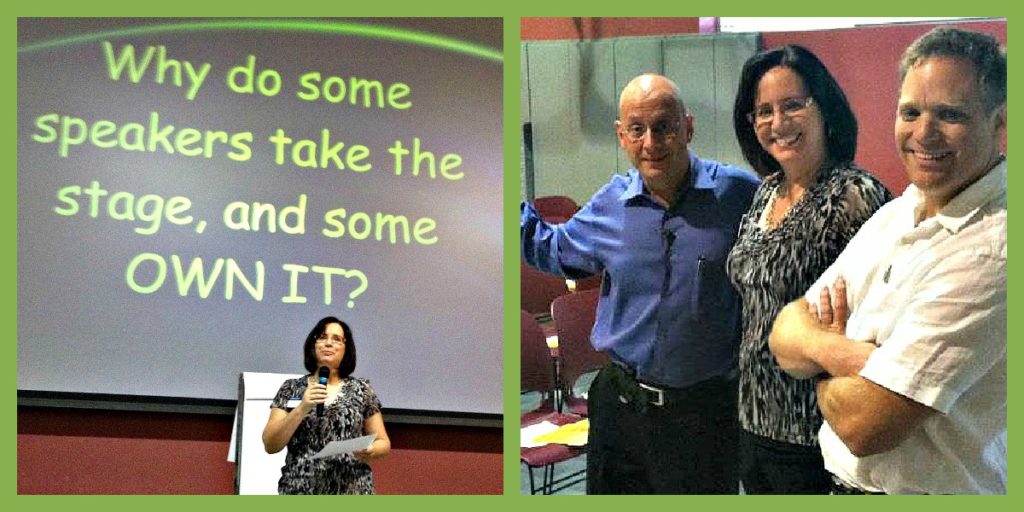Why Do Some Speakers OWN the Stage?
Tips from a Champ!
Tips from a Champ!
In August 2001, out of 25,000 contestants from 14 countries, Darren LaCroix (above in blue shirt) was crowned the 2001 World Champion of Public Speaking.
Last Thursday, Darren came to Minnesota and presented “Own the Stage Coaching” and I furiously took brief notes to share them with you (OK, I really took them for myself).
Let’s first look at the “must avoids” and then at the “must haves” when speaking.
Must avoid:
- Sameness. Of course you know that monotone is boring. But being at a high level of excitement throughout your speech can cause your audience to drift, too.
- Thinking too much about what you are going to say.
“If you’re in your head, you’re dead.”
Instead, if you are telling a story, for example, don’t just say the words, but be present in the story, feeling the emotion.
- Memorizing your speech. Not only can you sound too stilted, but memorizing your speech also can limit your ability to respond and adjust to the audience. Don’t memorize. Internalize. Also, Darren believes that it is OK to use notes, as long as you just briefly refer to them (don’t read). Your audience is there for CONTENT.
- Gestures. Gesturing just to have “gestures” can look almost comical. Think “body language” and allow your body to “speak.”
- Taking too long to get to the first story. And, when you get there, piling on too many details. Use more dialog and less narration.
“It doesn’t matter what you say; it matters what the audience sees when you say it.”
Must have:
- Audience–Do, Think, Feel. Know what you want your audience to think, feel or do when you are done speaking. Write this foundation of your speech in 10 or fewer words.
When you are done speaking, what do you want your audience to do, think or feel?
- Pause to reflect. Don’t pause for effect. If you ask the audience a rhetorical question, give them time to mentally answer the question. Or, as Darren says they say on the East Coast, “Shut up.”
The most important part of the presentation is the thought process of the person in the audience.
- You-focused questions. Don’t ask questions like, “Have any of you been to Las Vegas?” Instead say, “Have you been to Las Vegas?” Talk to the audience as though you are having a one-to-one conversation over coffee. Be aware of your I:YOU ratio.
Speak to one. Look to all.
- Holograms. Where ever you tell a story the audience makes a “hologram” of the scene. Be careful not to mix up your holograms. Darren gave the example of a speaker who told a story in which he knelt at his father’s coffin. Later in the speech, he told a story about his family going on a picnic. The speaker acted out spreading the picnic blanket in the same spot as–you guessed it–the coffin! Have your stories at different parts on the stage. Then you also can refer back to them with pointing to that same spot.
- Purposeful movement. Don’t just move from one side of the stage to the other out of nervous energy or the feeling that you have to talk to the other side of the audience. For example, move to other parts of the stage to make your points (the points can be at different parts of the stage, much like story scenes).
- Tap and Transport. Get your audience thinking about themselves (which taps into the WIIFM (What’s In It For Me?) question and then transport them into your story. As Darren mentioned, this concept comes from the 1999 World Champion Craig Valentine (Tap, Tease and Transport).
- Use VAKS within 60 seconds to bring the audience into your story. Use different modes of sensory communication at the start: Visual, Auditory, Kinesthetic (body movement) and Smell. Here’s an example (which I just made up), that uses VAK: Shaking like a high school student giving her first speech, I walked on stage and looked into 600 eyeballs as the conversations of the conference attendees went from a loud roar to a quiet murmur of anticipation.
- Transition Phrases. You can transition from point to point with silence, but you also can use effective transition phrases that tie your points together.
The example that Darren gave came from his world champion speech.
- Setting up point 1 (a story): Dr. Goddard had a ridiculous idea.
- Point 1: Dr. Goddard story
- Transition phrase: I remember when I had a ridiculous idea.
- Point 2: My ridiculous idea story
Do fewer of the “must avoids” and more of the “must haves” to take your speech from good to GREAT and OWN THE STAGE.
Side note: Don Matthews (to my right in the above picture) obtained a small stage, one that he got to keep, for the event. Don says, “Now I really OWN A STAGE!”
www.virtualspeechcoach.com


No comments:
Post a Comment